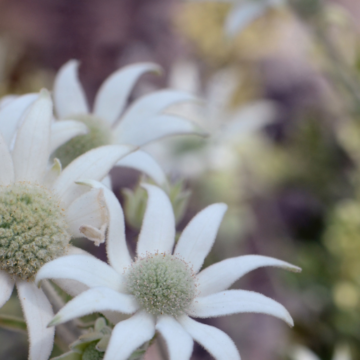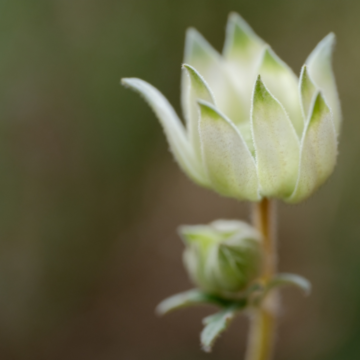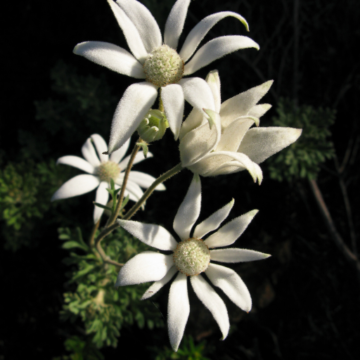Blog
Flannel Flower: Nature’s Delicate Beauty

In the vast tapestry of Earth’s botanical wonders, the flannel flower (Actinotus helianthi) emerges as a delicate, yet captivating star. Nestled within the Apiaceae family, the flannel flower has a rich history filled with cultural significance, celebrated artists and profound healing potential.
The flannel flower has deep roots in Aboriginal Australian culture, where it is known as the “Dhaaga” or “Dogwood.” Aboriginal communities have used the flannel flower for centuries, both for its striking appearance and for its medicinal properties. It holds cultural significance as a symbol of purity and spiritual connection to the land. Amidst the grandeur of Australia’s native floral wonders, the flannel flower emerges as a striking contrast. While many of its counterparts boast large, robust masculine blooms, the flannel flower captivates with its delicate and ethereal beauty. Its soft, woolly petals and intricate details stand as a testament to nature’s artistry, reminding us that beauty can be found in the most delicate of forms.
In Victorian times, flannel flowers symbolised a fresh start and new beginnings. Today, they continue to embody renewal, making them a popular choice in bridal bouquets and arrangements signifying new chapters in life.
Renowned Australian artists, including Margaret Preston https://www.ngv.vic.gov.au/explore/collection/work/75856/ and Ellis Rowan, https://www.artgallery.nsw.gov.au/collection/works/272.2007/ have been inspired by the flannel flower’s exquisite beauty. Their paintings and illustrations have immortalised this native blossom, contributing to its status as an iconic symbol of Australia’s unique flora.
Traditional Indigenous medicine recognised the flannel flower’s healing properties, using it to treat various ailments. Modern herbalists also value the plant for its potential anti-inflammatory and soothing effects. http://www.naturalmedicinalherbs.net/herbs/f/fremontodendron-californicum=flannel-flower.php#:~:text=Medicinal%20use%20of%20Flannel%20Flower%3A&text=In%20particular%2C%20it%20is%20a,or%20made%20into%20a%20liquid. While it’s not a mainstream remedy, some still turn to flannel flower extracts and infusions for their therapeutic qualities.
Besides its scientific name, the flannel flower is also known as the “flannel weed” due to its soft, woolly appearance. In the cut flower industry, it is prized for its unique texture and striking white or pink-tinged petals. It’s often used to add a touch of ethereal whimsy to arrangements.
Flannel flowers typically grow in sandy or well-draining soils in coastal regions of Australia. They thrive in the spring and summer seasons, reaching their peak bloom during these periods. Harvesting is done when the flowers are in full bloom, ensuring the best quality for cut flowers or medicinal purposes.
While Actinotus helianthi is the most well-known flannel flower, there are other rare and less common species within the Actinotus genus. These variations may have slightly different appearances and growth patterns but share the flannel flower’s endearing charm.
To witness a breathtaking display of flannel flowers, head to the Royal National Park in New South Wales, Australia. This park is renowned for its carpets of flannel flowers during the spring and summer seasons, creating a truly magical sight. https://www.nationalparks.nsw.gov.au/things-to-do/walking-tracks/flannel-flower-walking-track
Flannel flowers have a relatively good vase life, typically lasting up to a week or two with proper care. To maximise their longevity, place them in a clean vase with fresh water and trim the stems regularly. Keep them away from direct sunlight and drafts, as this can cause premature wilting.
The presence of flannel flowers in one’s surroundings can have a calming and mood-lifting effect. Their delicate appearance and soft texture evoke feelings of tranquility, making them a simple yet effective way to improve mental well-being.
Fun Facts:
- The flannel flower’s petals are actually bracts, not true petals.
- It is native to Eastern Australia, particularly in the states of New South Wales and Queensland.
- The leaves and stems of the flannel flower are covered in fine hairs, giving them their distinctive flannel-like texture.
In nature’s grand gallery, the flannel flower stands as a testament to the beauty and resilience of native flora. Its rich history, cultural significance and artistic allure continue to make it a cherished symbol of Australia’s botanical heritage.








